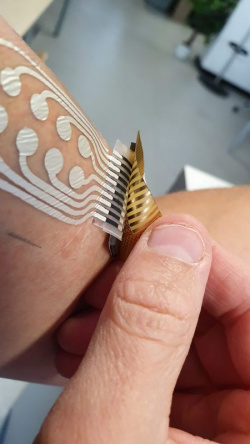Difference between revisions of "Flexible Electronic Systems and Embedded Epidermal Devices"
From iis-projects
(→Flexible Electronic Systems and Embedded Epidermal Devices) |
|||
| (21 intermediate revisions by the same user not shown) | |||
| Line 6: | Line 6: | ||
'''Flexible Electronic Systems''' utilize polymers and other flexible or strechable materials to form wearable and conformable devices. These system are often composed of various flexible, bendable but also small ridgid components, such as electrodes, transducers, energy storage units, transistors and complete IC's. | '''Flexible Electronic Systems''' utilize polymers and other flexible or strechable materials to form wearable and conformable devices. These system are often composed of various flexible, bendable but also small ridgid components, such as electrodes, transducers, energy storage units, transistors and complete IC's. | ||
| − | These designs allow for '''comfortable wear''', as they can be positioned closely to or even attached to the human body (as epidermal devices). In addition, and through the integration of '''digital electronic components,''' these devices can | + | These designs allow for '''comfortable wear''', as they can be positioned closely to or even attached to the human body (as epidermal devices). In addition, and through the integration of '''digital electronic components,''' these devices can perform '''a wide range of complex functions,''' such as continuous monitoring and modulation of physiological signals or communication with other devices. |
| − | However, the '''development''' of such systems | + | However, the '''development''' of such systems faces a '''number of challenges'''. These include not only material properties per se (e.g., flexibility, stretchability, or biocompatibility), but also reliability issues due to bending and mechanical stress on the entire hardware and signal stack, as well as interface challenges at all levels of integration. In addition, advanced and specialized manufacturing techniques are required for their fabrication. |
| − | |||
| − | |||
==Our Activities== | ==Our Activities== | ||
| + | Our research aims at '''improving the interconnectivity and processing reliability of digital circuits''' on flexible, stretchable substrates. This brings hardware intelligence ever closer to the skin surface. Additionally, we develop '''smart embedded solutions to optimize manufacturing processes'''. | ||
==Contact== | ==Contact== | ||
| − | + | ||
| − | + | ||
{| | {| | ||
| style="padding: 10px" | [[File:LeitnerChristophPortrait.jpg|frameless|left|100px]] | | style="padding: 10px" | [[File:LeitnerChristophPortrait.jpg|frameless|left|100px]] | ||
| | | | ||
| − | ===[[:User:Cleitne | Christoph Leitner]]=== | + | ===[[:User:Cleitne | Dr. Christoph Leitner]]=== |
* '''e-mail''': [mailto:christoph.leitner@iis.ee.ethz.ch christoph.leitner@iis.ee.ethz.ch] | * '''e-mail''': [mailto:christoph.leitner@iis.ee.ethz.ch christoph.leitner@iis.ee.ethz.ch] | ||
* '''phone''': +41 76 686 1179, '''whatsapp''': +43 664 15 63 900, '''skype''': chu.leitner | * '''phone''': +41 76 686 1179, '''whatsapp''': +43 664 15 63 900, '''skype''': chu.leitner | ||
| − | * '''Office''': ETZ | + | * '''Office''': ETZ J69.2 |
| + | |} | ||
| + | |||
| + | {| | ||
| + | | style="padding: 10px" | [[File:philippmayer.jpg|frameless|left|100px]] | ||
| + | | | ||
| + | ===[[:User:mayerph | Dr. Philipp Mayer]]=== | ||
| + | * '''e-mail''': [mailto:mayerph@iis.ee.ethz.ch mayerph@iis.ee.ethz.ch] | ||
| + | * '''phone''': +41 44 63 242 68, '''skype''': mayer.philipp1 | ||
| + | * '''Office''': ETF F108 | ||
|} | |} | ||
Latest revision as of 12:43, 23 July 2023
Contents
Flexible Electronic Systems and Embedded Epidermal Devices
Flexible Electronic Systems utilize polymers and other flexible or strechable materials to form wearable and conformable devices. These system are often composed of various flexible, bendable but also small ridgid components, such as electrodes, transducers, energy storage units, transistors and complete IC's.
These designs allow for comfortable wear, as they can be positioned closely to or even attached to the human body (as epidermal devices). In addition, and through the integration of digital electronic components, these devices can perform a wide range of complex functions, such as continuous monitoring and modulation of physiological signals or communication with other devices.
However, the development of such systems faces a number of challenges. These include not only material properties per se (e.g., flexibility, stretchability, or biocompatibility), but also reliability issues due to bending and mechanical stress on the entire hardware and signal stack, as well as interface challenges at all levels of integration. In addition, advanced and specialized manufacturing techniques are required for their fabrication.
Our Activities
Our research aims at improving the interconnectivity and processing reliability of digital circuits on flexible, stretchable substrates. This brings hardware intelligence ever closer to the skin surface. Additionally, we develop smart embedded solutions to optimize manufacturing processes.
Contact
Dr. Christoph Leitner
|
Dr. Philipp Mayer
|
Projects
All projects are annotated with one or more possible project types (M/S/B/G) and a number of students (1 to 3).
- M: Master's thesis: 26 weeks full-time (6 months) for one student only
- S: Semester project: 14 weeks half-time (1 semester lecture period) or 7 weeks full-time for 1-3 students
- B: Bachelor's thesis: 14 weeks half-time (1 semester lecture period) for one student only
- G: Group project: 14 weeks part-time (1 semester lecture period) for 2-3 students
Usually, these are merely suggestions from our side; proposals can often be reformulated to fit students' needs.
Available Projects
- Adaptively Controlled Polarization And Hysteresis Curve Tracing For Polymer Piezoelectrics (1 S/B)
- Development Of A Test Bed For Ultrasonic Transducer Characterization (1 S/B)
- Towards Flexible and Printable Wearables


